OLDER BALLADS MOSTLY BRITISH
Lord Thomas and Fair Annex (Child 73)
Of all the old ballads, this probably stands next to 'Barbara Allan' in popular favor. For its range in living tradition, both the old country and in America, see BSM 37-8 and add Tennessee (SFLQ XI 122-3), North Carolina (FSRA 23-4), Florida (SFLQ VIII 147-50), Arkansas (OFS i 99-101, 106-8), Missouri (OFS 1 94-9, 1 01 -6), Ohio (BSO 29-34), Indiana (BSI 58-70), Illinois (JAFL Lii 75-6), and Michigan (BSSM 37-9). American texts follow one general pattern with various differences in detail — mostly cases of leaving out or putting in. Of the fourteen texts in the Brown Collection only a few are here given in full.
A. [Lord Thomas and Fair Ellinor] 'Lord Thomas and Fair Annet.' Secured by Dr. Brown in 1898-99 in Rockingham county, Virginia — not strictly speaking a North Carolina version but given here as being probably the first ballad he ever collected. In the second line "door" should of course be "deer"; the Virginia singer knew nothing of any "keeper" of deer but had heard of doorkeepers. The spelling "a tire" in stanzas 4 and 8 — in the manuscript it is "a 'tire" — indicates that to the singer the word was not "attire" but "tire" as in "tirewoman." Is "nought" in stanza 15 phonetic for the singer's pronunciation of "nut"?
1 Lord Thomas he being a bold young man,
A keeper of our king's door.
Fair Ellen she being a clever young woman,
Lord Thomas be loved her dear.
2 He went into his mother's room:
'Come riddle to me this one,
Whether I shall marry fair Ellen,' he says,
*Or bring the brown girl home?'
3 'The brown girl she has house and land,
Fair Ellinor she's got none;
Therefore I beseech you with my blessing
Go bring the brown girl home.'
4 He dressed himself in a tire of red.
His merry men all in green.
And every town that he rode thro'
They took him to be some king.
5 He rode till he came to fair Ellinor's bower,
He rapped at the ring.
There was none as ready as fair Ellinor herself
To rise and let him in.
6 'What news, what news, Lord Thomas?' she said,
'What news have you brought unto me?'
*I have come to bid you to my wedding,
And that's bad news for thee.'
7 'Oh, God forbid. Lord Thomas,' she said,
'That any such a thing should be done ;
For I thought to be the bride my own self,
And you was to be the bridegroom.'
8 She dressed herself in a tire of red,
Her merry maids all in green,
And eviery town that she rode thro'
They took her to be some queen.
9 She rode till she came to Lord Thomas' bower.
She rapped at the ring;
There was no one so ready as Lord Thomas himself
To rise and let her in.
10 He took her by her lily-white hand
And led her in the hall;
He sat her at the head of the table
Among the ladies all.
11 'Is this your bride. Lord Thomas?' she said.
'I think she looks wonderful brown.
For you might have had the fairest young woman
That ever trod English groun'.'
12 The brown girl had a small pen-knife,
It being sharp and keen;
Betwixt the long ribs and the short
She pierced fair Ellinor's heart.
13 'Oh, what's the matter, fair Ellen?' he said.
'I think you look wonderful pale.
You used to be the fairest young woman
That ever trod English groun'.'
14 'Why, are you blind, Lord Thomas,' she said,
'Or can you not very well see?
For don't you see my own heart's bleed
Come trickling down my knee?'
15 Lord Thomas he having a nought broad sword.
It being sharp and keen.
He cut off the brown girl's head
And dashed it against the wall.
16. He put the helve unto the floor,
The point unto his heart.
Was there ever three lovers so simple together
That were so soon to part?
B. 'Fair Ellender and the Brown Girl.' From the collection of Miss Edith B. Fish of White Rock, Madison county. She had sent this and other ballads to C. Alplionso Smith in 1913; shortly thereafter she sent it to the North Carolina collection. It corresponds rather closely to A, but adds two stanzas after Lord Thomas's announcement of his coming wedding:
'Come father, come mother, come riddle my riddle
And riddle it all as one;
Whether I must go to Lord Thomas's wedding
Or tarry along at home.
'There are many there that will he my friends.
There are many will he my foes.
I've entered life, I'll enter death,
And to the wedding I'll go.'
And appends the familiar quatrain directing his funeral:
'Go dig my grave both wide and deep
And paint my coffin black.
And bury fair Ellender in my arms
And the brown girl at my back.'
C. 'Lord Thomas and Fair Ellenter.' From the collection of Miss Louise Rand Bascom, Highlands, Macon county. It is a somewhat defective text — lines are missing in places. Only Ellenter asks advice from her mother; as the lines stand, she does not get it, but declares that she will go to the wedding anyhow:
It's I would go to Lord Thomas's weddin'
If my coffin was in at my door.'
Miss Bascom notes a distinction of sex in the matter of summoning people to the door: Lord Thomas "jangled up the rein" but Fair Ellenter "jingled at the rein." This text, also, ends with the burial directions.
D. 'Lord Thomas.' Collected by Thomas Smith of Zionville, Watauga county, in or before 1914. In that year he was in lively correspondence with C. Alphonso Smith (who was himself a North Carolinian) on the subject of ballads and sent him this text among others. Later C. A. Smith released all his North Carolina gatherings to the North Carolina Folklore Society. Thomas Smith wrote in 1914 that this ballad is "written as sung by Miss Ida Wilson, whose father sang it nearly sixty years ago." Sixteen stanzas. Only Lord Thomas seeks maternal advice. In stanza 10 appears a faint memory of the sharp dialogue between Aniiet and the brown girl in Child's versions AEG (and in most of the other versions less strikingly):
'Where did you get your well water
That washed your skin so white?'
But Ellender makes no reply, at least not to the brown girl. The customary stanza directing the burial at the close.
E. 'Lord Thomas and Fair Ellender.' Sent in in 1914 by D. W. Fletcher of RED 4 near Durham, from the singing of D. E. Holder, who learned it from his mother. The "mense" of stanzas 3 and 8 stands perhaps for "immense"; line 2 of stanza 3, meaningless in this place, is probably merely a careless anticipation of the same line in stanza 8; "before" in stanza 2 should apparently be "therefore."
1 'O mother and father, come riddle my riddle,
Come riddle us both as one,
Whether I marry fair Ellender
Or bring the brown girl home.'
2 'The brown girl she has house and land,
Fair Ellender she has none;
Before I charge you with my great blessing
To bring the brown girl home.'
3 He dressed himself in mense array,
This maid in morning-green,
And every village he rode through
They taken him to be some king.
4 He rode unto fair Ellender's hall,
He knocked so loud at the ring;
There was none so ready as fair Ellender herself
To rise and welcome him in.
5 'Oh, what is the matter, Lord Thomas?' she cried,
'What news have you brought to me?'
'I have come to ask you to my wedding.
And I'm sure it's sad news to tell.'
6 'Now mother and father, come riddle us now,
Come riddle us both as one,
Whether I go to Lord Thomas' wedding
Or stay with you at home.'
7 'There's many that be there that be your friends.
There's many that be your foe.'
'But little do I care for all of that;
To Thomas' wedding I'll go.'
8 She dressed herself in niense array,
Her maid in morning[1] green,
And every village she rode through
They taken her to be some queen.
9 She rode up to Lord Thomas' hall;
So loud she knocked at the ring;
There was none so ready as Lord Thomas himself
For to rise and welcome her in.
10 He taken her by her lily-white hand
And led her through the hall
And set her down at the end of the table
Above his own bride and all.
11. 'O Thomas, O Thomas, is this your bride?
I think slie looks wonderful brown,
When once you could have married as fair a skin lady
As ever the sun shone on.'
12 The brown girl she had a little pen-knife,
'Twas both keen and sharp.
Between the long ribs and the short
She retched fair Ellender's heart.
13 'Oh what is the matter?' Lord Thomas he cried,
'What makes you look so pale,
When you once used to carry as red rosy cheeks
As ever shined under a veil ?'
14 'O Thomas, O Thomas, are you not blind?
Why, can't you very well see?
I think I feel my own heart's blood
A-trickling down by me.'
15 Lord Thomas he had a little bright sword
A-hanging in the hall.
He cut off his own bride's head
And stove it against the wall.
16 Lord Thomas he had a little pen-knife,
'Twas both keen and sharp.
He put the handle against the ground
The point against his heart.
17 He placed the handle against the ground
And the point against his chest,
Saying, 'Here lies the death of three long lovers.
Lord, send our souls to rest!
18. 'O mother and father, go dig my grave,
And dig it wide and deep,
And bury fair Ellender by my side
And the brown girl at my feet.'
F. 'Lord Thomas and Fair Eleanor.' Contributed by Professor E. L. Starr of Salem College in January 1915. There is no record of whence he got it. A quite normal text of fourteen stanzas. The only thing that seems to call for comment is "a knock so loudly ring" in stanzas 3 and 7. Here "ring" has become a verb whereas properly it is the metal ring of a door-knocker.
G. 'Lord Thomas and Fair Eleanor.' Sent in by I. G. Greer of Boone, Watauga county, probably in 1915. Though for the most part a quite regular text, it has some details that justify giving it in full. Spelling the "brown girl" with a capital B suggests that it is understood as a family name. The entire omission of the stabbing has a somewhat startling effect.
1 'Father, O father, come riddle this riddle,
Come riddle it all as one;
What must I do? Go marry fair Eleanor,
Or bring the Brown girl home?'
2 'The Brown girl she has house and land,
Fair Eleanor she has none;
So for your own blest good, my son,
Go bring the Brown girl home.'
3 He dressed himself in silk so fine,
His waistbands all in green,
And every town that he rode round
They took him to be some king.
4 He rode up to fair Eleanor's gate,
So lightly tapped the ring;
No one so ready as fair Eleanor herself
To rise and let him in.
5 'What news, Lord Thomas, what news,' said she,
'What news have you for me?'
'I've come to ask you to my wedding.'
' 'Tis very bad news,' said she.
6 'Mother, O mother, come riddle this riddle,
Come riddle it all as one.
What must I do? Go to the wedding,
Or tarry this day at home?'
7 'Daughter, O daughter, I've riddled your riddle.
I've riddled it all as one;
The best advice I can give to you
Is to tarry this day at home.'
8 But she dressed herself in silk so fine,
Her waistbands all in green,
And every town that she rode through
They took her to be some queen.
9 She rode up to Lord Thomas' gate,
So lightly tapped the ring;
No one so ready as Lord Thomas himself
To rise and let her in.
10 'Is this your bride? Is this your bride?
She looks so very brown.
And you could have married as fair a young lady
As ever the sun shone on.'
11 Lord Thomas he squealed and he squalled:
'What makes you look so pale?
You used to wear as red rosy cheeks
As ever shone under a veil.'
12 *Oh, are you blind, that you can't see
Your bride has murdered me?
I feel my own, my own heart's blood
Come trinkling down by me.'
13 He took the Brown girl by the hand.
He led her into the hall,
And with a sword he chopped her head off
And kicked it against the wall.
14 'Father, O father, go dig a grave,
Dig it both wide and deep;
Lay fair Eleanor by my side
And the Brown girl at my feet.'
15 He put the sword against the wall,
The point against his breast,
Saying, 'Father, O father, here's three true lovers;
God send their souls to rest!'
H. 'Lord Thomas.' Sent in by I. G. Greer in 1919 from the singing of his cousin Miss Fannie Grogan of Silverstone, Watauga county. A fairly normal text of twelve stanzas. Both Thomas and Ellinor consult their respective mothers. There are, however, some passages corrupted to the point of being unintelligible. The first two lines of stanzas 3 and 6 run:
He went he dressed all in his best
His majesty, they were brown
and
She went she dressed all in her best.
Her majesty. They were green
and the account of the stabbing runs:
The brown girl she had a little pen knife
With blades both keen and sharp
Between the long blade and the short
She pierced fair Ellinor right in the heart.
I. 'Lord Thomas.' From the singing of Mrs. Alice Cooke of Boone, Watauga county, in 1922. The text seems somewhat disordered as regards rhythm and rhyme, but perhaps this will be explained in vol. IV, for the text here is taken from the musical score. Lord Thomas "splits his bride in twain" instead of cutting off her head.
J. 'The Brown Girl.' Taken down by Mrs. Sutton from the singing of Mrs. Brown of Beech Mountain, Watauga county, "one of the twenty-odd singers in the Blue Ridge from whom I collected this ballad," Mrs. Sutton notes. It is a normal text of fifteen stanzas. Only Fair Ellender's dress is described, not Thomas's. There is a new phrase in stanzas 2 and 6:
He called up his merry merry men
By one, by two, and by three
She called up her merry merry men
By one and by two and by three
The death of Lord Thomas is told in a way to make it seem accidental, but that is probably not what is meant to be understood:
He threw the sword against the floor.
The point flew up in his breast.
Now lie three lovers all in a row ;
God send them home to rest.
K. 'Lord Thomas and Fair Ellinor.' From Mary Scarborough of Dare county; the only text from tidewater North Carolina. Eighteen stanzas. Has the familiar ballad repeat at the end of each stanza:
Lord Thomas he was a very fine man,
A hunter of the king's deer;
Fair Ellinor she was a very fine lady,
Lord Thomas he loved her well well well,
Lord Thomas he loved her well.
Thomas asks his father and mother to riddle his riddle, stanza 2; Ellinor does the same, stanza 7. Thomas
dressed himself in very red,
In very red and green,
and Ellinor repeats the procedure a few stanzas later.
L. "Lord Thomas.' Contributed by W. A. Abrams in 1939 from the singing of Mrs. J. E. Spence of Siler City, Chatham county. An unusually full text, nineteen stanzas, yet it lacks entirely Ellen's scornful remark about her rival's complexion which motivates the brown girl's assault.
M. 'Lord Thomas and Fair Eleanor.' Reported by Mrs. R. D. Blacknall of Durham as "sung by an elderly seamstress in my great-grandfather's family between 1812 and 1820." The longest of all the North Carolina texts, and interesting by reason of its divergencies from customary readings. It is dirticult, in the customary versions, to reconcile Eleanor's sumptuous array and equipment with her status as dowerless girl, it is still more so when we have her presented as the only daughter of the king's high dame.
1 Lord Thomas, Lord Thomas he was a brave man ;
He courted the king's high dame.
She had but one own fair daughter —
Fair Eleanor was her name.
2 'O mother, O mother, come riddle to me,
And riddle us both as one,
And say shall I marry the fair Eleanor
Or bring the brown girl home?'
3 'The brown girl she hath both house and lands,
Fair Eleanor hath none.
So I would advise you with all of my mind
To bring the brown girl home.'
4 He clad himself in velvet fine.
His waiters all in white;
And every town that they passed through
They took him to be some knight.
5 He rode and he rode till he came to the castle ;
He made the knocker to ring.
There was none so ready as the fair Eleanor
To rise and let him in.
6 'What news, what news. Lord Thomas?' she cried,
'What news do you bring to me?'
'I come to invite you to my wedding.
Tomorrow it is to be.'
7 'Bad news, bad news, Lord Thomas,' she cried,
'Bad news do you bring to me.
I thought to have been myself your bride
And you bridegroom to me.
8 'O mother, O mother, come riddle to me,
And riddle us both as one.
And say shall I go to Lord Thomas's wedding
Or tarry alone at home?'
9 'There are many that are our friends, daughter,
But thousands are our foes.
So I would advise you with all of my mind
To Lord Thomas's wedding don't go.'
10 'There are many that are our friends, mother,
Though thousands be our foes.
So, betide me life, betide me death,
To Lord Thomas's wedding Til go!'
11 She clad herself in satin fine,
Her maidens all in green,
And every town that she passed through
They took her to be some queen.
12 She rode and she rode till she came to the hall;
She made the knocker to ring.
There was none so ready as Lord Thomas himself
To rise and let her in.
13 He took her by her lily-white hand.
He led her through the hall,
He led her into an upper room
Where sat the ladies all.
14 'Is this your bride. Lord Thomas?' she cried,
'Methinks she looks wondrous brown,
When you might have had so fair a lady
As ever the sun shone on!'
15 'Oh, speak no ill,' Lord Thomas said,
'Oh, speak no ill of she;
For I do love your little finger more
Than I do her whole body.'
16 The brown girl she had a little pen-knife,
And it was keen as a dart;
And between the short ribs and the long
She pierced fair Eleanor's heart.
17 'Oh, you are blind, Lord Thomas,' she cried,
'Or can't you very well see?
Oh, don't you see my young heart's blood
Come trickling down to my knee?'
18 Lord Thomas he had a sword by his side.
And it was sharp and small;
And with it he cut off the brown girl's head
And he flung it against the wall.
19 'Oh. dig my grave, oh, dig my grave,
And dig it wide and deep.
Bury fair Eleanor in my arms,
The brown girl at my feet.'
20 He placed the hilt upon the ground,
The point against his heart.
Did ever three lovers meet together
So very soon to part?
N. 'Fair Eleanor.' Contributed by Mrs. Rigsbee, apparently of Durham. An incomplete version of eight stanzas, lacking all of the story preceding Eleanor's question whether she shall go to Lord Thomas's wedding, and lacking also the stanzas in which Eleanor reveals her wound to Thomas; nothing distinctive in the stanzas that remain.
------------------
19 Lord Thomas and Fair Annex (Child 73) Music
'Lord Thomas and Fair Annet.' Sung by anonymous singer. Secured in Rockingham county, Virginia, 1898-99. Cf. note, II 69.

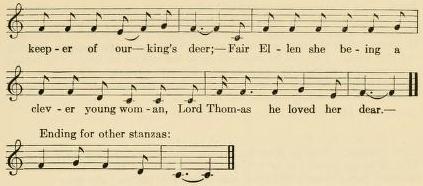
For melodic relationship cf. *SharpK i 115, No. 19A, measures 1-2, especially measure 2. The identical progressions of the latter occur in the same measure of 8 versions in Sharp's volume, but in only 3 of our Collection. ASb 156, meas-
ures 1-4.
Scale: Irrational, plagal. Tonal Center: f. Structure: abab1 (2,2,2,2) = aa1 (4,4)-
------------------
A(1) 'Lord Thomas and Fair Annet.' Sung by Mrs. Nora Hicks. Recorded at Mast's Gap, Watauga county, August 28, 1940. Also entitled 'Lord Thomas and Fair Ellinger.' With one minor exception measures 1, 3, and 4 are identical with those of the Miller, Greer, Cooke, and Brown versions. In the Greer version even measure 5 is identical melodically.
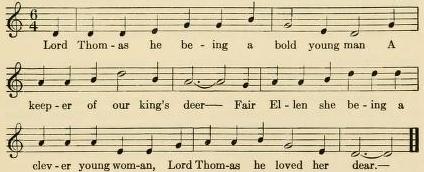
For melodic relationship cf. *SharpK i 115, No. 19A, measures 1-4; TBV 570, No. 18R; FSOA 108, measure 1.
Scale: Mode III, plagal. Tonal Center: g. Structure: aa1a2a3 (2,2,2,2) = aa1 (4,4). Circular Tune (V).
This song shows an interesting use of the melodic material. Measures 3-4 are a contraction of 1-2. The second half of the first measure is omitted in the third, but this resulting deficiency is made up by lengthening the values in the
fourth. The following two measures (5-6) basically represent a varied repetition of the two preceding them, well exemplifying the general tendency towards balance and also characteristic of musical expression. This is here accomplished by compensating for any upward movement with one in the opposite direction and vice versa. This can be observed up to the end of the song. The limited tonal material certainly has been used to the best advantage. This is particularly noteworthy when it is realized that these creations are not the product of a highly trained musical imagination.
D. 'Lord Thomas.' Sung by Miss Ida Wilson. Secured by Thomas Smith of Zionville, Watauga county, in or before 1914. A note on the ms score, however, mentions Sam Flannery as having also contributed the text and tune.
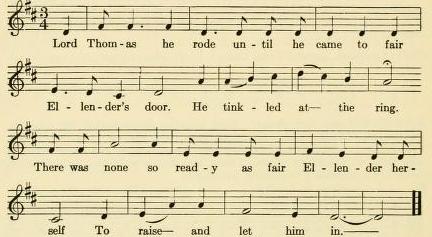
Scale: Hexatonic (4), plagal. Tonal Center: d. Structure aba1b1 (5,3,4.4)- This shows a rather unusual structure, which nevertheless comes about in quite a normal way. Both the cadences of the first and second phrases were shortened to the extent of one measure. Another possibility would be to assume that the first phrase was internally incremented. But this would still demand another measure at the end of the second phrase. This second manner of analysis has one factor to recommend it ; e.g., the first phrase would thereby take on the form of the third and the smooth progression into the second phrase would be very much like that from the third to the fourth.
E. 'Lord Thomas and Fair Ellender.' Sung by D. E. Holder. Procured by D. W. Fletcher of Durham, RFD 4. This is the melody to 'Lord Thomas and Fair Annet' mentioned together with 'Barbara Allen' as having probably been sent in by Dr. I. G. Greer. The assumption of the editor, as expressed in II 131, to the effect that one tune had to do double duty for both texts, is not borne out by the facts. There are actually two separate and distinct melodies, one for each song. Perhaps the fact that both melodies were written on a single small sheet of manuscript paper was responsible for this deduction.
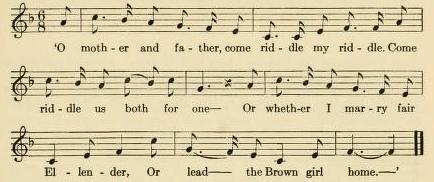
Scale: Irrational, plagal. Tonal Center: f. Structure: aba^bi (2,2,2,2) = aa1 (4,4). Interesting here again is the use of the melodic material. The second half of measure 1 plus the first half of measure 2 serve to furnish the last two measures. Naturally, we find again the rhythmic shift.
E(1) 'Lord Thomas and Fair Ellender.' Sung by Mrs. Myra Barnett Miller. Recorded probably at Lenoir in August of 1939, 1940, or 1941. Another title is 'Brown Girl.' The first four measures are identical with those of the Greer and Cooke versions. The close relationship with the Brown version is pointed out also in the latter. There is also some melodic relationship with the Hicks version. Measures 1-4 of this version are also related to those of 'The Seven Sisters' by Mrs. James York, and 'Pretty Cold Rain' by Miss Hattie McNeill.
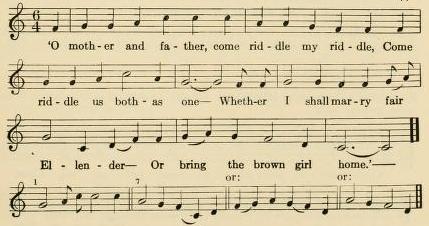
For melodic relationship cf. **SharpK I 119-20, No. 19F and H; BSM 45, as well as TBV 570, No. 18R, and OFS i 94, No. 15A. Likewise FSF 268, No. 157B, and BSSM 37, No. 4-
Scale: Mode III, plagal. Tonal Center: f. Structure: aa1bb1 (2,2,2,2) = ab(4,4). The identical approach to both cadences should be mentioned. Circular Tune (V).
G. 'Lord Thomas and Fair Eleanor.' Sung by I. G. Greer. Recorded probably in 1915. Sung again for the present editor at Chapel Hill in 1952. The first four measures are practically identical with those of the Miller version. Considerable similarity with 'The Seven Sisters' by Mrs. James York and 'Pretty Cold Rain' by Hattie McNeill.
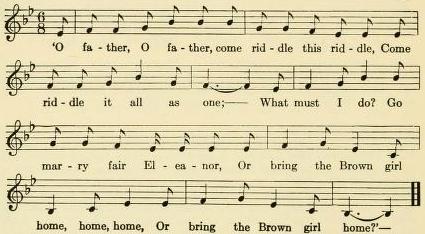
For melodic relationship cf. **SharpK i 119-20, No. 19 F and H; BSM 45; TBV 570, No. 18R; FSF 268, No. 157B; BSSM 37, No. 4.
Scale: Mode III, plagal. Tonal Center: e-flat. Structure: aa^abbi (2,2,2,2,2) = ab (4,6). The second phrase is terminally incremented. Circular Tune (V).
H. 'Lord Thomas.' Sung by Miss Fannie Grogan. Recorded at Silverstone, Watauga county, 1919.


Scale: Hexatonic (4), plagal. Tonal Center: f. Structure: abed (2,2,2,2) Circular tune (V).
I. 'Lord Thomas.' Sung by Mrs. Alice Cooke. Recorded at Boone, Watauga county, in 1922. This is a compound of parts of two versions: a variation of the first two lines of stanza 1, version E and a variation of the third stanza of version M. No doubt the original version was in quatrains. The original eight measures, whichever they were, followed this pattern. When the textual corruption took place, enlarging the stanza to six lines, the tune had to be lengthened also. It is easy to see that the first eight measures constitute what we usually consider a normal tune, even if, as in this case, it is a circular tune; and that by omitting measures 7-10 we should have a perfect cadence. But the tune as given here is adapted to the change of text. It should be noted that the first four measures of this version are almost identical with those of the Miller version.
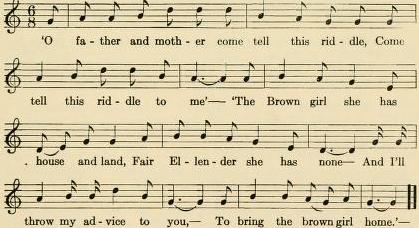
For melodic relationship cf. **BSM 45; TBV 570, No. 18R; FSF 268, No. 1S7B ; and BSSM 37, No. 4.
Scale: Mode III, plagal. Tonal Center: g. Structure: aa1bb1a2c (2,2,2,2,2,2) =abc (4,4,4) ; the c is partially related to a; and b, although considerably altered, is derived from measures 2-3 of a.
J. 'The Brown Girl.' Sung by Mrs. Brown. Contributed by Mrs. Sutton at Beech Mountain, Watauga county, no date. (One catalogue gives 1921-25.) Excepting the slightly varied measures 5-6, this tune is identical with that of the Miller version. Measures 1-4 are practically the same as those in the Cooke version.
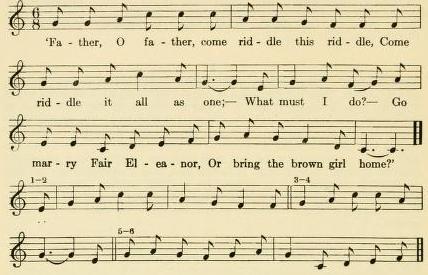
For melodic relationship cf. **BSM 45; TBV 570, No. 18R; FSF 268, No. IS7B ; and BSSM 37, No. 4.
Scale: Hexachordal. Tonal Center: c. Structure: aa1bb1 (2,2,2,2) = ab (4,4).
K. 'Lord Thomas and Fair Ellinor.' Sung by C. K. Tillett. Recorded on Roanoke Island, December 29, 1922.
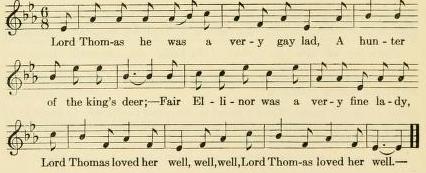
For melodic relationship cf. **SharpK i 115, No. 19A. The basic melodic tendency is closely related.
Scale: Mode III, plagal. Tonal Center: a-flat. Structure: abcdd1 (2,2,2,2,2). The second phrase b is terminally incremented. Circular Tune (V).
M. 'Lord Thomas and Fair Eleanor.' Sung by anonymous female singer. Contributed by Mrs. R. D. Blacknall of Durham: catalogue gives 1921? This version is melodically related to that of Horton Barker. These two songs share in a melodic idiom (measure 2) which in songs of the same name occurs likewise in only two versions. The idiom is known by the popular term 'Scotch snap' otherwise knov/n as alia lombardo. The two songs in the Sharp collection can be found in SharpK i 121-25, Nos. 19 J and Q. Our tune has in common with the Miller version, Ex, another melodic peculiarity, a downward skip of a sixth. While this skip is found in only two of our versions, in Sharp's collection it occurs quite frequently, although in different measures. Cf. SharpK i 115-31, Nos. 19 A, C, D, F, G, I, J, S, and Ee.
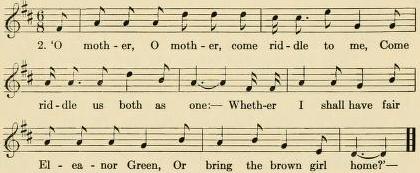
For melodic relationship cf. **SharpK I 125, No. 19P, measures 3-4 and 7-8, and No. 19H, measures i and 3-4; Also TBV 569, No. 18 (D) II. *BSSM 37. No. 4.
Scale : Heptachordal. Tonal Center: d. Possibly mm1n (2,2,4) = barform. Structure: aa1bc (2,2,2,2) = ab (4,4).
M (1). 'Lord Thomas and Fair Eleanor.' Sung by Mrs. J. J. Miller. Recorded at Silverstone, Watauga county, no date.


For melodic relationship cf. **SharpK i 127, No. 19V; the main points in the melodic tendency coincide.
Scale: Hexachordal, plagal. Tonal Center: a. Structure: aa^bc (2,2,2,2) = ab (4,4). Perhaps also mm^n (2,2,4) = barform. Circular Tune (V).
O. 'Lord Thomas and Fair Annet.' Sung by Horton Barker. From record made by Dr. W. A. Abrams at Boone, September 14, 1941. At his home in Chilhowie, Virginia, Barker sang the same version for the present editor in the summer of 1952.
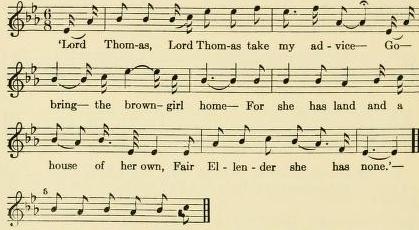
For melodic relationship cf. **SharpK i 127, No. 19U. Coincidence of the basic melodic line. *TBV 569, No. 18 (D) IL
Scale: Mode III, plagal. Tonal Center: a-flat. Structure: aa1bc (2,2,2,2) = ab (4,4). Circular Tune (V).
P. 'Lord Thomas and Fair Annet.' Sung by Mrs. Rebecca (Aunt Becky) Gordon. Recorded at Asheville, July 19, 1939. Mrs. Gordon learned her songs from her mother, who was born and reared near Tuxedo, Henderson county. Another title given is 'O, Lily O.' There is no first stanza on the recording; the text of the remainder can only partially be understood. Textually, the form reminds one of version K, particularly in the repetition of the penultimate line.
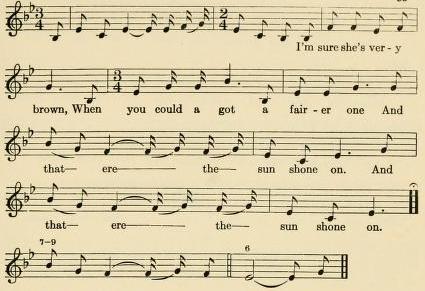
For melodic relationship cf. *SharpK i 115, No. 19A, measures 1-2 and 5. In the latter, the daring ascending skip of a sixth leading into the upper octave is, in our version, more cautiously undertaken : first a fourth, then a third, and again a third.
Scale: Mode III, plagal. Tonal Center: e-flat. Structure: abcddi (2,2,2,2,2); the second phrase is terminally incremented.
3 And a . . . . . sharp knife
That'd just lately
He it. . . . . through . . . heart
And the blood came tinkling, tinkling down.
And the blood came tinkling, tinkling down.
4 Lord Thomas, Lord Thomas, don't you see
And don't you. . . .
. . . . . . .
Your heart's blood came tinkling down,
Your heart's blood came tinkling down.
5 Go dig my grave both deep and wide
And paint my coffin black,
. . . . . . . .
Q. 'Lord Thomas and Fair Eleanor.' Sung by Mrs. Ephraim Stamey. Recorded at Altamont, Avery county, July 14, 1940. The stanza is closely related to the fourth stanza of our version M.
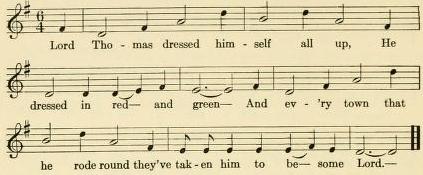
For melodic relationship cf. *SharpK I 124, No. 19M, measures 3-4. Scale: Mode IH. Tonal Center: d. Structure: abab1 (2,2,2,2) = aa1 (4,4).